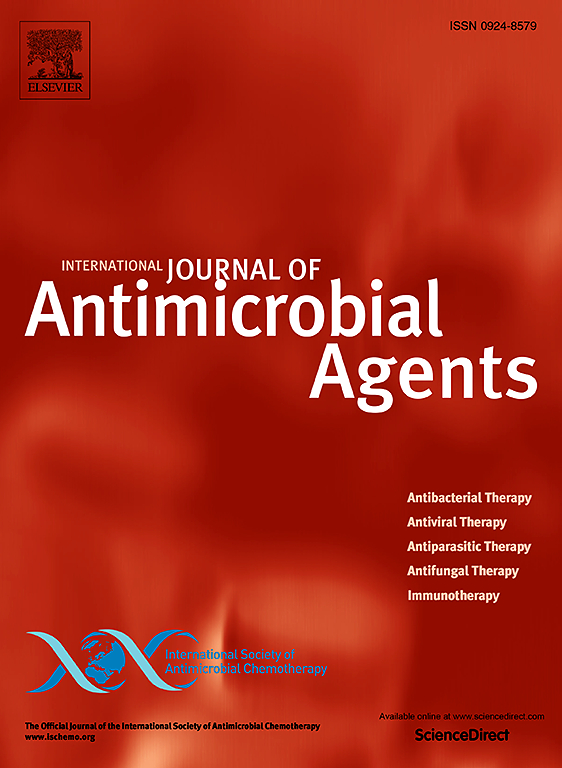Emergence of a novel transferable megaplasmid driving blaVIM-24 and tmexCD3-toprJ3 dissemination in clinical Pseudomonas fulva isolates
IF 4.6
2区 医学
Q1 INFECTIOUS DISEASES
International Journal of Antimicrobial Agents
Pub Date : 2025-08-20
DOI:10.1016/j.ijantimicag.2025.107594
引用次数: 0
Abstract
Objective
To investigate the genetic characteristics and transmission mechanism of clinical Pseudomonas fulva isolates with transferable megaplasmid co-carrying blaVIM−24 and tmexCD3-toprJ3.
Methods
Bacterial identification was performed using MALDI-TOF/MS, and antimicrobial susceptibility testing was carried out using agar dilution and broth microdilution. The genetic context of drug resistance genes and plasmid characteristics was analyzed by S1-PFGE, Southern blotting, conjugation experiments, and whole-genome sequencing analysis. Comparative genomics analysis of the plasmids and genetic context was conducted by using BLAST Ring Image Generator (BRIG) and Easyfig 2.3. Phylogenetic analysis of P. fulva strains and pJBCL41-like megaplasmids was performed by Snipy and Mega, respectively.
Results
Clinical P. fulva strains, ZDHY316 and ZDHY414, with transferable megaplasmids co-carrying blaVIM−24 and tmexCD3-toprJ3. The megaplasmids pVIM-24-ZDHY316 and pVIM-24-ZDHY414 carry multiple drug-resistant genes and integrate numerous integrons and transposon truncations from different origins. ΔTn6855-ΔTn6758 is the new discoovered co-transfer module carrying nfxB-mexCD-oprJ, which only exists in chromosomes and megaplasmids. Phylogenetic analysis of pJBCL41-like megaplasmids showed their evolution towards carrying more drug-resistance genes and mobile genetic elements. Additionally, ZDHY316 has another transferable plasmid, pVIM-1-ZDHY316, which carries the novel integron In2008 with the GCA of 5ʹCS- blaVIM-1-aac(6ʹ)-Ib-3ʹCS. Phylogenetic analysis of P. fulva strains showed that China is the country with the most P. fulva isolated clinically, with strains prevalent and evolving in hospitals.
Conclusions
The mosaic structure of the megaplasmid, characterized by integrons and transposons, underscores its role in resistance gene dissemination and highlights the adaptability of non-standard pathogens like P. fulva. The horizontal transfer potential of this megaplasmid poses a significant challenge to clinical infection control. Enhanced surveillance of non-standard pathogens and their plasmids is essential.
一种驱动blaVIM-24和tmexCD3-toprJ3在富氏假单胞菌临床分离株中传播的新型可转移质粒的出现
富氏假单胞菌是一种罕见的假单胞菌机会致病菌,在人类中引起罕见的临床感染。新的耐药机制tmexd - toprj及其变异的出现,对抗感染治疗提出了新的挑战。本文描述了两株临床富氏疟原虫ZDHY316和ZDHY414的完整序列,其可转移的巨质粒共同携带blaVIM-24和tmexCD3-toprJ3。巨质粒pVIM-24-ZDHY316和pVIM-24-ZDHY414不仅携带多种耐药基因(包括blaVIM-24和tmexd3 - toprj3),而且还整合了来自不同来源的许多整合子和转座子截断。同时,在巨质粒上发现了携带nfxB-mexCD-oprJ (ΔTn6855-ΔTn6758)的新型共转移模块。它仅存在于染色体和巨质粒中,为nfxB-mexCD-oprJ的传递机制提供了新的参考。系统发育分析显示pjbcl41样巨质粒向携带更多耐药基因和MGEs的方向进化。此外,ZDHY316有另一个可转移质粒携带blaVIM-1, pVIM-1-ZDHY316。pvim -1- zdh316是pLD209的衍生质粒,在2008年携带了新的整合子,GCA为5'CS-blaVIM-1-aac(6')-Ib-3'CS。富氏假单胞菌的系统发育分析表明,中国是临床分离到富氏假单胞菌最多的国家,菌株在医院流行并不断进化。以整合子和转座子为特征的巨型质粒的镶嵌结构强调了其在抗性基因传播中的作用,并突出了对富氏疟原虫等非标准病原体的适应性。这种巨型质粒的水平转移潜力对临床感染控制提出了重大挑战,特别是在医院等高风险环境中。为了减轻这类耐药性媒介的传播,加强对非标准病原体及其质粒的监测至关重要。
本文章由计算机程序翻译,如有差异,请以英文原文为准。
求助全文
约1分钟内获得全文
求助全文
来源期刊
CiteScore
21.60
自引率
0.90%
发文量
176
审稿时长
36 days
期刊介绍:
The International Journal of Antimicrobial Agents is a peer-reviewed publication offering comprehensive and current reference information on the physical, pharmacological, in vitro, and clinical properties of individual antimicrobial agents, covering antiviral, antiparasitic, antibacterial, and antifungal agents. The journal not only communicates new trends and developments through authoritative review articles but also addresses the critical issue of antimicrobial resistance, both in hospital and community settings. Published content includes solicited reviews by leading experts and high-quality original research papers in the specified fields.

 求助内容:
求助内容: 应助结果提醒方式:
应助结果提醒方式:


